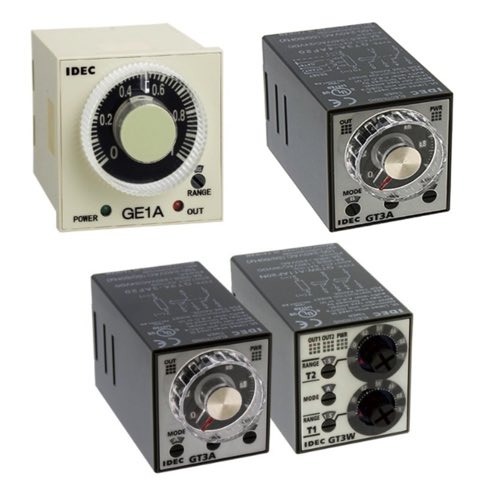IDEC Time Delay Relays

IDEC time delay relays are multifunctional and versatile devices, designed to provide precise control over delay intervals in a variety of industrial applications. These relays are capable of multiple timing functions such as on delay, off delay, signal on/off delay, and one shot, allowing for customization according to specific process requirements. The delay cycle can be adjusted to suit different time ranges, making these relays adaptable for various operational needs.
A key feature of IDEC time delay relays is their ease of installation. Many models are designed for standard DIN rail mounting, making them easy to integrate into existing control systems. The DIN rail mount socket and socket screw type pin design facilitate secure and reliable attachment, often complemented by finger safe features for enhanced safety during installation and maintenance.
More Information about IDEC Time Delay Relays
Additionally, IDEC time delay relays are available in a range of power specifications, including common industrial voltages like 24VAC/DC and 240VAC, ensuring compatibility with a wide array of electrical systems. The relays are also designed to be used with panel mount adapters, offering flexibility in installation options, whether on a DIN rail or in a control panel.
The delayed SPDT (Single Pole Double Throw) configuration in some IDEC time delay relays adds to their functionality, providing a reliable switch operation over the designated time span, from as short as 0.1 seconds to longer durations. This feature is particularly useful in applications where precise timing and switch reliability are crucial.
IDEC time delay relays are engineered to meet the demanding requirements of industrial control systems, offering multi-functionality, adjustable delay cycles, safe and easy mounting options, and compatibility with various power systems. Their robust design and key features like adjustable time ranges and multiple delay functions make them a valuable component in enhancing the efficiency and precision of industrial processes.
What is a Relay & How it Works
What is a relay?
A relay is an electrically operated switch. Most relays use an electromagnetic to operate the switch. An electromagnet is a device that creates a magnetic field by passing an electrical current through a coil of wire. The magnetic field is then turned off when the current is removed.
Why use relays?
Relays are commonly used when there is a need to control a switch with high voltage or circuits with large amounts of current passing through them. Operating these types of switches manually can be dangerous, inefficient and impractical. By using relays, operational safety is increased while also providing the ability to use smaller, safer and less expensive electrical equipment to control devices. Using relays allow for control of several devices on a single switch, as opposed to using several switches for each device. Relays can be combined with timers and logic circuits to assist in electrical automation.
How do relays work?
A relay consists of two separate circuits that work together to open or close a switch (or contacts). The first circuit drives the coil (or electromagnet). The electricity passes through the coil, creating a magnetic field. The second circuit contains a set contacts and a separate power source. This circuit is what provides power to the electrical load.
When electricity passes through the coil, it creates a magnetic field. This magnetic field pulls the contact from the other circuit closed (or against the stationary contact) which will allow current to pass through the contacts, therefore allowing the load to become energized. When the coil is de-energized, the magnetic field is gone which allows the contact to be pushed back into its original state, de-energizing the load side of the circuit.

